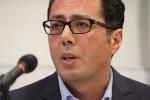Why Are We Gambling With America’s Future?
Advertisement
Supported by
David Brooks
By David Brooks
Opinion Columnist
Over the past few decades, in a surge of bipartisan national self-confidence, the federal government has borrowed a lot of money, sometimes in response to national emergencies and sometimes to do the things people thought were worth doing. We gave ourselves permission to incur all this debt because interest rates were low and many people assumed that things would stay that way, so the costs of carrying that much debt wouldn’t be too onerous.
Unfortunately, that assumption turned out to be incorrect. Interest rates have risen. According to The Wall Street Journal, America is expected to spend $870 billion, or 3.1 percent of gross domestic product, this year on interest payments on the federal debt. According to the Committee for a Responsible Federal Budget, the government will spend more on interest payments than on the entire defense budget. Within three years, if interest rates remain high, payments on the debt could become the federal government’s second-largest expenditure, behind Social Security.
When money is tight, as it is now, government borrowing competes with private borrowing, driving interest rates up for everybody. A 2019 Congressional Budget Office study found that every 10 percent increase in the debt-to-G.D.P. ratio results in an increase in interest rates of two-tenths to three-tenths of a percentage point. That makes voters miserable, as they are now, because it’s more expensive to, say, get a mortgage or some other kind of loan.
It makes government accountants miserable because the very act of borrowing money to pay off debt can drive interest rates higher and make the prospect of paying off debt even........
© The New York Times






















 Toi Staff
Toi Staff Andrew Mitrovica
Andrew Mitrovica Belen Fernandez
Belen Fernandez Gideon Levy
Gideon Levy Rachel Marsden
Rachel Marsden Tarik Cyril Amar
Tarik Cyril Amar Warren J. Blumenfeld
Warren J. Blumenfeld Dr Ramzy Baroud
Dr Ramzy Baroud Patrick Gathara
Patrick Gathara Brad Glosserman
Brad Glosserman
